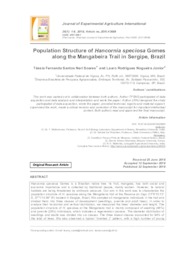Population Structure of Hancornia speciosa Gomes along the Mangabeira Trail in Sergipe, Brazil.
Population Structure of Hancornia speciosa Gomes along the Mangabeira Trail in Sergipe, Brazil.
Author(s): SOARES, T. F. S. N.; NOGUEIRA JUNIOR, L. R.
Summary: Hancornia speciosa Gomes is a Brazilian native tree. Its fruit, mangaba, has both social and economic importance and is collected by traditional people, mainly women. However, its natural habitats are being threatened by anthropic pressure. Our aim in this work was to characterize the population structure of H. speciosa along the Mangabeira trail at the Reserva do Caju (11°6?10.12? S, 37°11?4.59? W) located in Sergipe, Brazil. We sampled all mangabeira individuals in the trail and divided them into three classes of development (seedlings, juvenile and adult trees). In order to analyse their horizontal and vertical distribution, we measured the trees' diameter and height. The population structure of H. speciosa at the Mangabeira trail is mainly composed of seedling (46%) and juvenile (29%) individuals, which indicates a regeneration process. The diameter distribution of seedlings and adults was divided into six classes. The three lowest classes accounted for 94% of the total of trees. We also observed a typical ?inverted J? pattern, with a high number of young plants, which is common to tropical forests. In terms of their vertical distribution, the majority of the individuals were classified under the lower stratum, which corresponded to 47% of the total population featuring 1.01-m average height. The high coefficient of variation in the lower stratum may explain the heterogeneity of the vertical structure, formed by individuals with different strategies to capture sun light and different behaviour towards resources supply. Thus, it is not possible to state that this population is in balance.
Publication year: 2018
Types of publication: Journal article
Unit: Embrapa Territorial
Observation
Some of Embrapa's publications are published as ePub files. To read them, use or download one of the following free software options to your computer or mobile device. Android: Google Play Books; IOS: iBooks; Windows and Linux: Calibre.
Access other publications
Access the Agricultural Research Database (BDPA) to consult Embrapa's full library collection and records.
Visit Embrapa Bookstore to purchase books and other publications sold by Embrapa.

